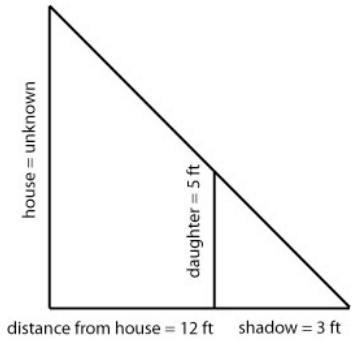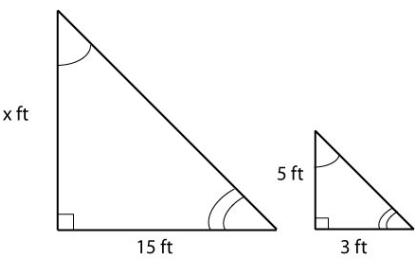A Bit of Geometry
Learning Outcomes
- Given the part and the whole, write a percent
- Calculate both relative and absolute change of a quantity
- Calculate tax on a purchase
 Let's start things off with an example, rather than trying to explain geometric concepts to you.
Let's start things off with an example, rather than trying to explain geometric concepts to you.
Example
Answer: There are several approaches we could take. We’ll use one based on triangles, which requires that it’s a sunny day. Suppose the tree is casting a shadow, say 15 ft long. I can then have a friend help me measure my own shadow. Suppose I am 6 ft tall, and cast a 1.5 ft shadow. Since the triangle formed by the tree and its shadow has the same angles as the triangle formed by me and my shadow, these triangles are called similar triangles and their sides will scale proportionally. In other words, the ratio of height to width will be the same in both triangles. Using this, we can find the height of the tree, which we’ll denote by h: [latex-display]\frac{6\text{ ft. tall}}{1.5\text{ ft. shadow}}=\frac{h\text{ ft. tall}}{15\text{ ft. shadow}}[/latex-display]
Similar Triangles
We introduced the idea of similar triangles in the previous example. One property of geometric shapes that we have learned is a helpful problem-solving tool is that of similarity. If two triangles are the same, meaning the angles between the sides are all the same, we can find an unknown length or height as in the last example. This idea of similarity holds for other geometric shapes as well.Guided Example
Mary was out in the yard one day and had her two daughters with her. She was doing some renovations and wanted to know how tall the house was. She noticed a shadow 3 feet long when her daughter was standing 12 feet from the house and used it to set up figure 1. Figure 1.
Figure 1. Figure 2.
Figure 2.Areas
| Rectangle | Circle, radius r |
| Area: [latex]L\times{W}[/latex] | Area: [latex]\pi{r^2}[/latex] |
| Perimeter: [latex]2l+2W[/latex] | Circumference[latex]2\pi{r}[/latex] |

| Rectangular Box | Cylinder |
| Volume: [latex]L\times{W}\times{H}[/latex] | Volume: [latex]\pi{r^2}h[/latex] |

Examples
If a 12 inch diameter pizza requires 10 ounces of dough, how much dough is needed for a 16 inch pizza?Answer: To answer this question, we need to consider how the weight of the dough will scale. The weight will be based on the volume of the dough. However, since both pizzas will be about the same thickness, the weight will scale with the area of the top of the pizza. We can find the area of each pizza using the formula for area of a circle, [latex]A=\pi{r}^2[/latex]: A 12" pizza has radius 6 inches, so the area will be [latex]\pi6^2[/latex] = about 113 square inches. A 16" pizza has radius 8 inches, so the area will be [latex]\pi8^2[/latex] = about 201 square inches. Notice that if both pizzas were 1 inch thick, the volumes would be 113 in3 and 201 in3 respectively, which are at the same ratio as the areas. As mentioned earlier, since the thickness is the same for both pizzas, we can safely ignore it. We can now set up a proportion to find the weight of the dough for a 16" pizza: [latex-display]\displaystyle\frac{10\text{ ounces}}{113\text{in}^2}=\frac{x\text{ ounces}}{201\text{in}^2}[/latex-display] Multiply both sides by 201 [latex]\displaystyle{x}=201\cdot\frac{10}{113}[/latex] = about 17.8 ounces of dough for a 16" pizza. It is interesting to note that while the diameter is [latex]\displaystyle\frac{16}{12}[/latex] = 1.33 times larger, the dough required, which scales with area, is 1.332 = 1.78 times larger.
The following video illustrates how to solve this problem. https://youtu.be/e75bk1qCsUEExample
A company makes regular and jumbo marshmallows. The regular marshmallow has 25 calories. How many calories will the jumbo marshmallow have?Answer: We would expect the calories to scale with volume. Since the marshmallows have cylindrical shapes, we can use that formula to find the volume. From the grid in the image, we can estimate the radius and height of each marshmallow. The regular marshmallow appears to have a diameter of about 3.5 units, giving a radius of 1.75 units, and a height of about 3.5 units. The volume is about π(1.75)2(3.5) = 33.7 units3. The jumbo marshmallow appears to have a diameter of about 5.5 units, giving a radius of 2.75 units, and a height of about 5 units. The volume is about π(2.75)2(5) = 118.8 units3. We could now set up a proportion, or use rates. The regular marshmallow has 25 calories for 33.7 cubic units of volume. The jumbo marshmallow will have: [latex-display]\displaystyle{118.8}\text{ units}^3\cdot\frac{25\text{ calories}}{33.7\text{ units}^3}=88.1\text{ calories}[/latex-display] It is interesting to note that while the diameter and height are about 1.5 times larger for the jumbo marshmallow, the volume and calories are about 1.53 = 3.375 times larger.
For more about the marshmallow example, watch this video. https://youtu.be/QJgGpxzRt6YTry It
A website says that you’ll need 48 fifty-pound bags of sand to fill a sandbox that measure 8ft by 8ft by 1ft. How many bags would you need for a sandbox 6ft by 4ft by 1ft?Answer:
Answer: 2.5 ft
Licenses & Attributions
CC licensed content, Original
- Revision and Adaptation. Provided by: Lumen Learning License: CC BY: Attribution.
CC licensed content, Shared previously
- Math in Society. Authored by: Lippman, David. Located at: http://www.opentextbookstore.com/mathinsociety/. License: CC BY-SA: Attribution-ShareAlike.
- Rice Terraces. Authored by: Hoang Giang Hai . License: CC BY: Attribution.

